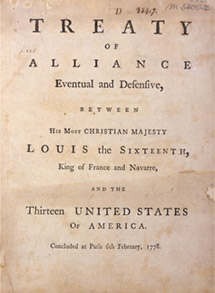 |
There shall be a firm, inviolable and universal Peace, and a true and sincere Friendship between the most Christian King, his Heirs and Successors, and the United States of America. —Treaty of Amity, February 6, 1778 |
| |
|
Miniature portrait of Louis XVI, 1784 |
|
Le Docteur Francklin couronné par la Liberté, 1778 |
|
In 1778 the Treaties of Amity and Commerce (commonly known as the Treaty of Amity) produced a strategic alliance between the United States and France, in which each nation agreed to aid one another in the event of British attack. Already at war with Britain, the new American nation needed significant support in the form of loans, military supplies, and troops. The Treaty officially brought France into the American Revolutionary War, providing aid at a crucial time and ultimately enabling the Americans to win their fight for independence. Negotiating the Treaty on behalf of the United States were Benjamin Franklin, Silas Deane, Arthur Lee, and Conrad Alexander Gerard. |
|
|
 |
|
Treaties of Amity and Commerce, 1778 |

